Kangaroo Island 2020

[AUTHOR'S NOTE: Realizing I have neither the time nor the energy to write full posts about my two-week trip to Australia, especially when I have already written fairly extensively in my email photo digests / travelogues, I decided the smartest and most efficient move would be to post the content of those five emails here, backdated. The following was posted on Tuesday, March 10 PST, but was originally sent to my email list late evening Sunday, March 8, local time in Adelaide, where we were when I sent it.]
Thursday, March 5, 2020

Shobhit and Uncle David (my mom's older brother) are flanked by myself and Mary Ann, Uncle David's wife of 40 years, on the ferry to South Australia's Kangaroo Island. The ferry leaves from the southwestern-most point on Fleurieu Peninsula, about a 75-miinute drive (52 miles) from Morphett Vale, the suburb south of Adelaide where Uncle David and Mary Ann live.
We all got up very early to catch the 9 a.m. ferry, after Shobhit and I flew from Melbourne to Adelaide the evening prior.

At our first major stop on Kangaroo Island, Seal Bay, there are the remains of a juvenile humpback whale that washed ashore east of the lookout in a 1984 storm. They were moved bone by bone to this spot further inland on the beach and easily observable from the boardwalk, to help preserve them, in 1996. They measure about 33 feet in length.
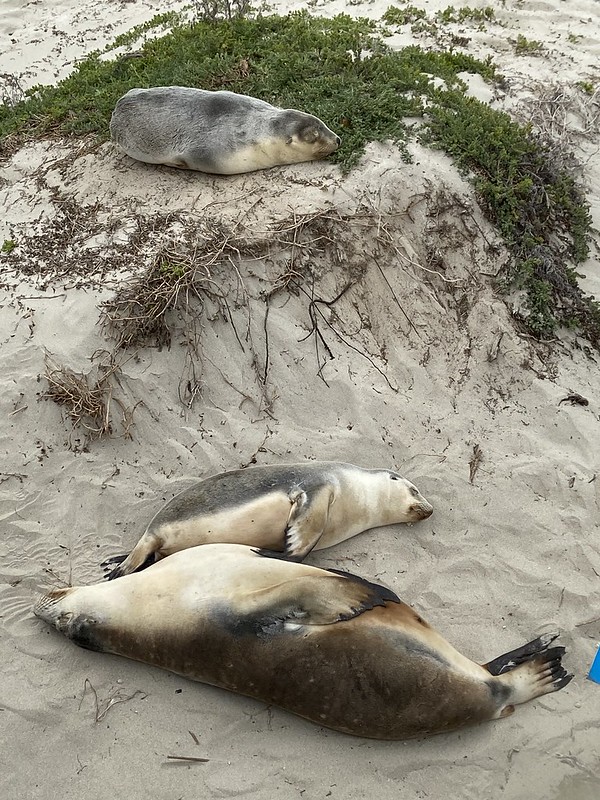
Actual seals at Seal Bay! You had two options here: a guided tour taken down closer to the seals on the beach for $37 (AUD) per person; or a self-guided tour along the boardwalk for $16.50. We clearly made the smarter choice going for the latter, as not only did we see plenty of seals along the length of the beach, but these guys were all napping just under where we walked along the boardwalk closest to the water. Who needs a guided tour! That may not have even gotten us this close.


Remember when I mentioned during the photos of the train ride between Sydney and Melbourne that Australia produces 25% of the world's wool? Well, it may be called Kangaroo Island, but the island is host to upwards of 600,000 sheep—and that's after an estimated 100,000 of them died in the recent bush fires. Even after that, we never saw any kangaroos om the island at all (with the exception of one dead one that was roadkill 🙁), but we saw tons of sheep. Sometimes they were rather loud.
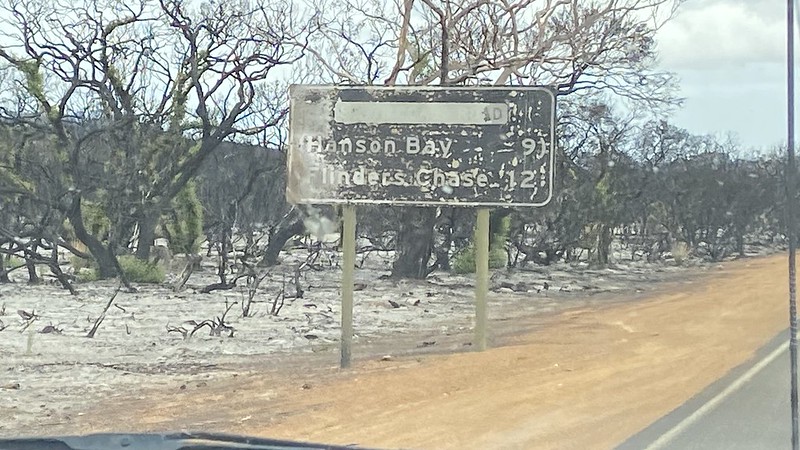
Two huge attractions we were unable to make it to this visit, which I had really wanted to see: Remarkable Rocks, and Admiral's Arch. Mary Ann had thought Flinders Chase National Park, which takes up about the western third of the island and was nearly completely burned in bush fires, would be open when we were there, but we got to the entrance and she turned out to be mistaken. (Side note: when Mary Ann and Shobhit got out of the truck to speak with a ranger at the gate, the lady pointed out to them a deadly tiger snake crossing the road a bit on the other side of that gate.)
Having driven as far as the gate, though, we got plenty close to see some of the bush fire devastation, as you can see here. This is probably the best representative photo I took of fire damage.

In spite of the still-very-prevalent fire damage, there was still already a great many signs of the resilience of life all over the island, as with this tree Mary Ann examines with its fresh greenery over charred bark.

They even sell my beloved Blue Diamond Almond Breeze at the other end of the world! This was at the Vivonne Bay General Store and Bottle Shop. Not my preferred vanilla flavor though, the bastards! (Side note: the entire permanent resident population of Kangaroo Island is 4,702. Kingscote, the main town located on the northern shore and where we stayed overnight one night, contains about half the population at 1,790. Vivonne Bay, however, is on the south coast of the island.)


This was easily the highlight of my visit on Kangaroo Island, even though the circumstances were certainly sad: We were driving up an unpaved road, and we spotted a wild koala—the only one we saw on the island, although the island apparently still has 5,000 of them, and that is drastically reduced from an estimated 60,000(!) before the bush fires, which was so high they had become pests and a nuisance. I was so stoked to see one, though, we all got out of the truck and I got a couple brief videos.
According to Mary Ann, generally speaking if you see them just hanging out on the ground instead of up in a tree—and this one had been spotted near a garbage can by someone's house—it means they are not at all doing well. An older lady came out of the nearby house to talk to us, with a voice that made her sound like she'd been smoking for forty years, telling us there aren't usually koalas in this part of the island but she's been seeing a lot of them. She said with so much of their habitat burned—and eucalyptus leaves are the only thing they eat—a lot of the ones that are left are starving. The lady spoke as though there just wasn't much to do ("That's mother nature for you!") but Mary Ann later spoke to someone in the hopes of getting wildlife aides out to help the animal.

Still at Vivonne Bay, getting into midafternoon we were getting hungry for lunch, and Mary Ann had packed us a bunch of vegetables, hard boiled eggs, and crackers to go with the cheeses Shobhit bought to bring from Queen Victoria Market in Melbourne. We found a road that was clearly near a picturesque part of the beach, so we laid out Shobhit's and my blanket tote for a sandy picnic. (When we arrived at Adelaide Airport with two full suitcases as well as a backpack and duffle bag in tow, Mary Ann quipped, "Are you staying for three months?" But hey, we like to be prepared! And we also brought things like the blanket tote for occasions just like this one.) It was indeed sandy, though, as a lot of it blew into our food. We seemed to fare okay, though. Is beach sand high in fiber?

After later settling into our hotel in Kingscote on the north side of the island, I tagged along with Mary Ann to check out the local cemetery. Cemeteries interest her because of her extensive research in family genealogy. (Mary Ann is a native of South Australia; Uncle David met her shortly after moving to Adelaide for a teaching job in 1974.) On our way back to the hotel from the cemetery, I took several photos of local birds, including this huge flock of corellas, which are Australian white cocaktoos. Also, Mary Ann got this great shot of me taking the above photo.
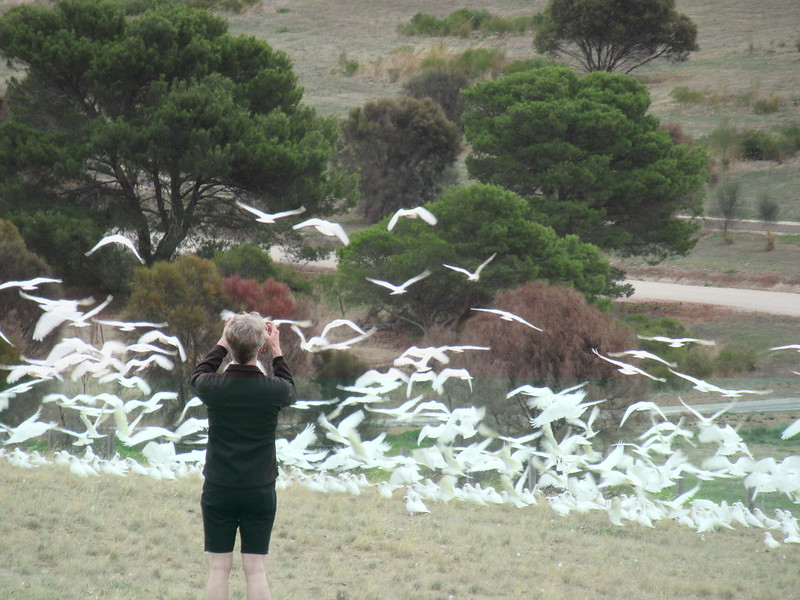
Friday, March 6, 2020

First stop on our second day: Island Beehive, where they sell honey from a species of bees that only lives on the island. That "claim to fame" seems slightly dubious to me, however, as the bees are not native to the island and were actually introduced from Italy in 1881. That said, this purebred species of Ligurian beens apparently no longer exists in Italy, which means the only ones left in the world are on Kangaroo Island. Or so the marketers of this honey say, anyway.
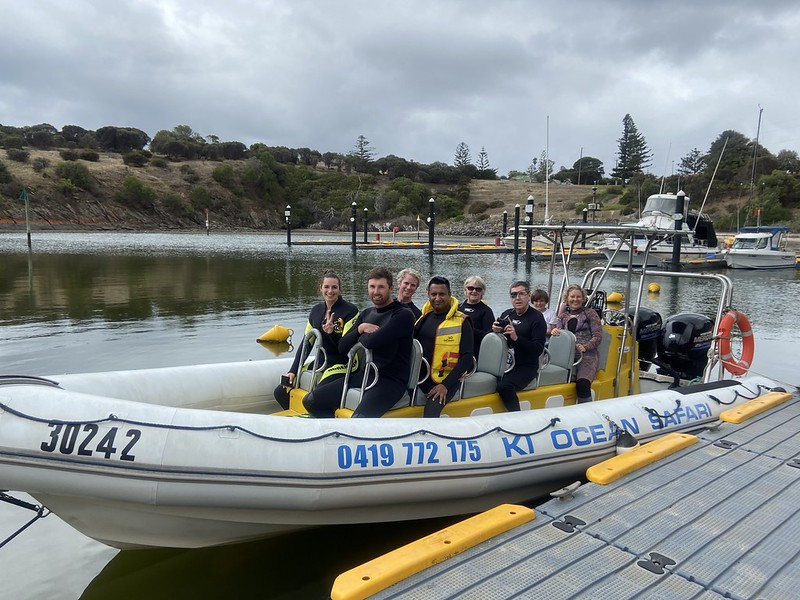
In our early email exchanges, Uncle David had asked if we would like to swim with dolphins. I immediately said, "Hell yeah!" Shobhit, who was copied on every single one of these emails but apparently does not like to pay attention, started saying the morning of the excursion that he hoped something would force it to be canceled. He is not a particularly good swimmer and it made him nervous. He did have the option of staying on the boat, but he accepted a life jacket and still initially came out into the water with the lot of us onto the rope with buoys we were to hold onto as the boat pulled us slowly along where dolphins would be. Still, only a few minutes in, he freaked out a little and asked to come back onto the boat, where he stayed for the rest of our time out on the water. Which was fine, because it allowed him to take some good photos while I was too busy swimming.
You can see Shobhit and me in the second row back from the front. The couple in front of us was a newlywed couple on their honeymoon, from a small town about five hours' drive into South Australia from the ferry dock on the mainland side. The guy is a sheep farmer, of course. (Side note: South Australia is the country's fourth-largest state in land area, and still it's 30% larger than Texas—but with a total population of 1.8 million, 77% of which is in Greater Adelaide.) Uncle David and Mary Ann are behind us.
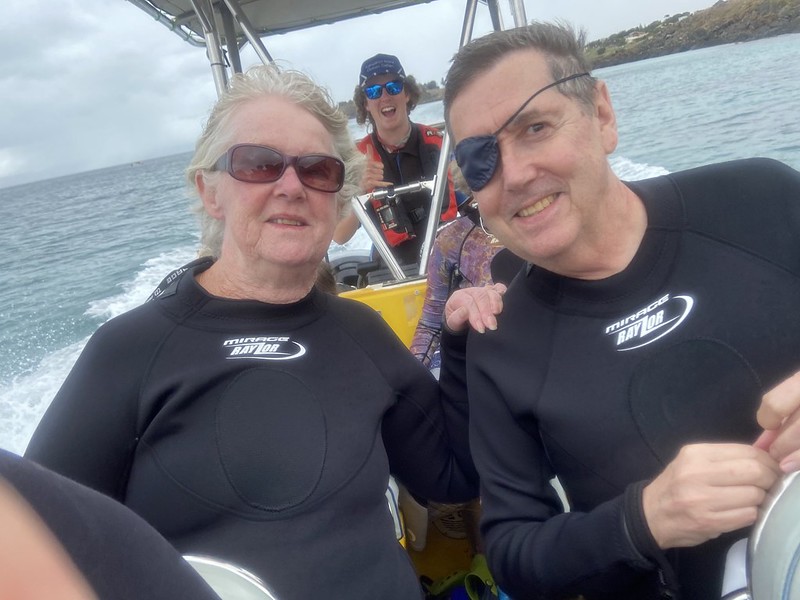
Elijah, the cute 22-year-old guy guiding our tour and operating the entire company from Kangaroo Island on his own for the past three years, strikes a pose in the background driving the boat while I snap this shot of Uncle David and Mary Ann behind us.
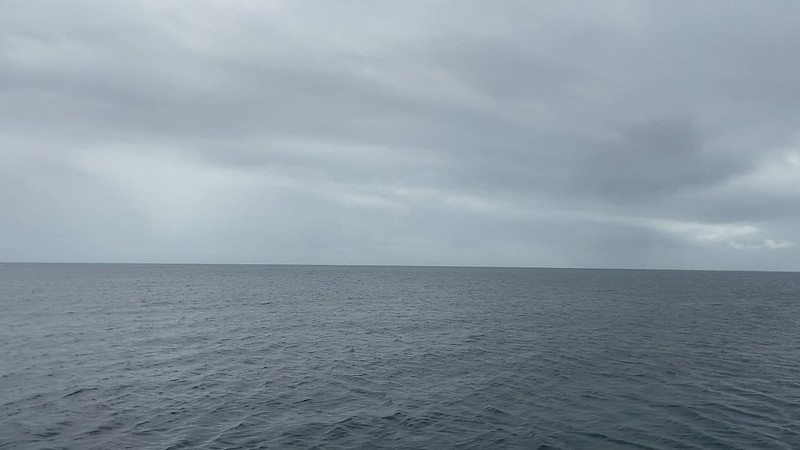

And, we did indeed see plenty of dolphins! Uncle David had a waterproof camera to use, and I even had a waterproof case for my iPhone that Shobhit bought at Big 5 Sporting Goods, which was useful for how wet it was just being on the boat—but, I still didn't want to risk dropping it while in the water so I did not take it swimming with me. Thus, I got no underwater shots of the dolphins, alas. I only barely managed to see them beneath the water, once I finally figured out where to look using the snorkel, and only after Elijah turned the boat around a second time to catch the dolphins swimming by. I saw them for maybe two seconds, a whole bunch of them gliding by below us, and you know what? That made the whole thing worth it.

The other wildlife we got to see on this excursion was seals, and this was the best photo I got of one from the boat (it's perched on the rock ledge, just to the right of the crack running vertically down the center of the photo). We did more snorkeling here, not being pulled by a rope this time but swimming around with flippers on our feet. And two times I did see a seal zipping by just above the rocks that were maybe twenty feet below the surface. Those things are bigger than you might think.

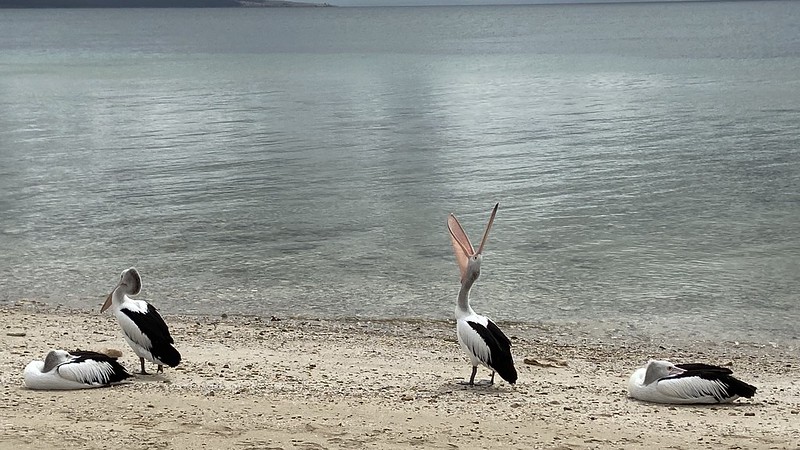
At another beach a bit later in the day: I woke up some pelicans from a nap.

Don't panic! This photo is not to scale. It's probably, I don't know, 400% of scale? The spider was pretty tiny—but it was living on a web stretched in the space between the frame of the truck and the end of the back passenger door, visible only when you opened it. I'm kind of amazed how easily cobwebs and spider webs generate in little secret places around here.
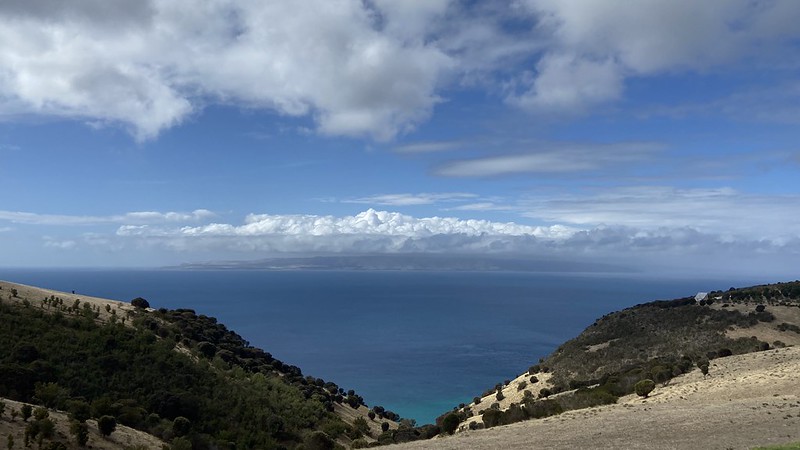
A lovely northward view from one of Kangaroo Island's wineries, where we had a tasting and then Shobhit bought two bottles of wine for us to share over the next couple of days in Adelaide. The land visible in the distance is the mainland, the end of Fleurieu Peninsula.

The very distinctive lighthouse at Cape Jervis on the mainland side, as seen from the ferry on our return. Also: thanks to both wind and solar power being used extensively in South Australia, according to Uncle David, the state is often running on renewable energy exclusively.

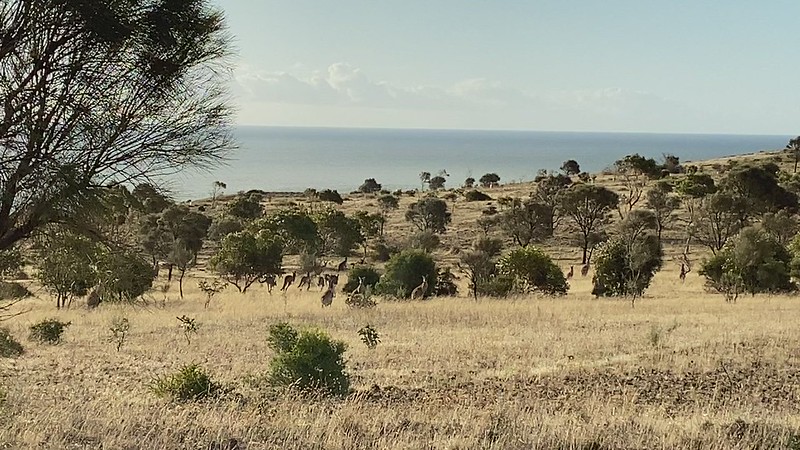
I can't find any estimates of kangaroo numbers on the island, but I did find one article saying 40% of them died in the island's bush fires. That presumably means there remains a good number of them, but unfortunately, the single kangaroo we actually spotted on the island was the dead one that was roadkill on the side of the road. But! South Australia is rife with these things on the mainland side—and we saw bunches of them almost as soon as we drove off the ferry. In fact, we saw so many of them even Uncle David and Mary Ann were struck by their numbers. Cumulatively, we must have seen at least a couple hundred of them on our way back to Adelaide.
[All Kangaroo Island photo albums on Flickr here; all overall Australia 2020 photo albums here.

